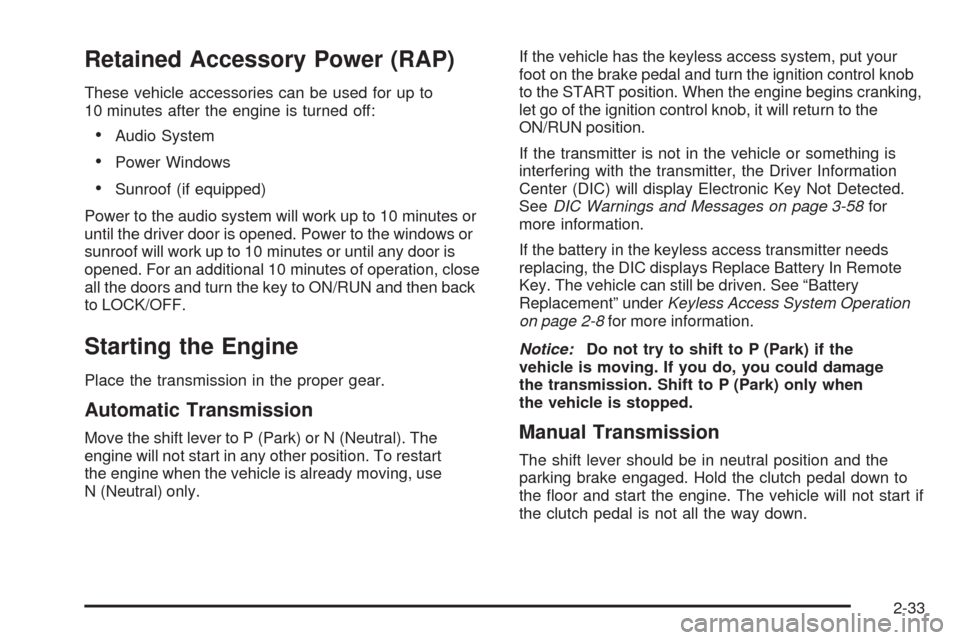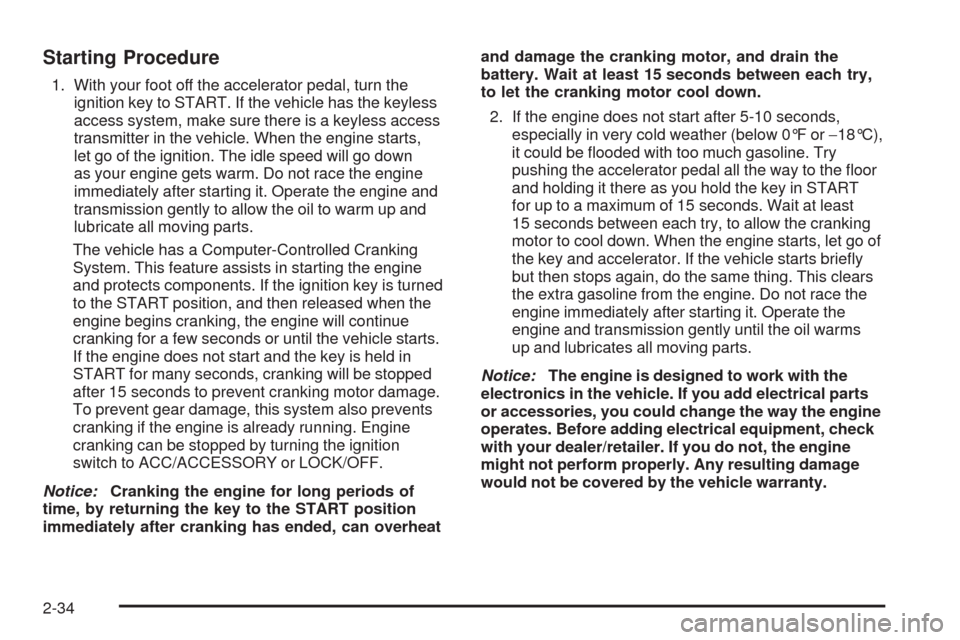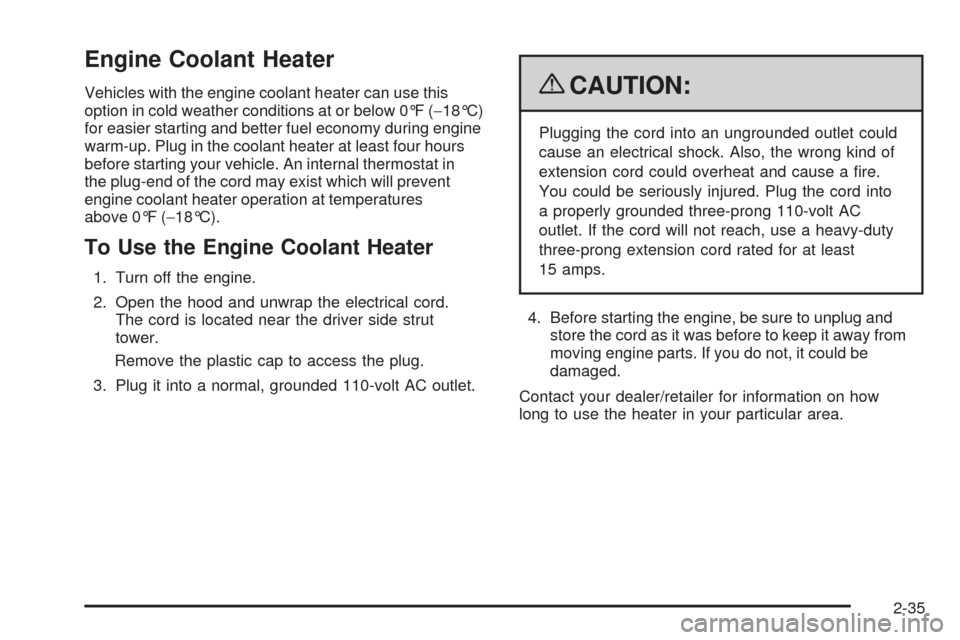engine CADILLAC CTS 2009 2.G User Guide
[x] Cancel search | Manufacturer: CADILLAC, Model Year: 2009, Model line: CTS, Model: CADILLAC CTS 2009 2.GPages: 490, PDF Size: 2.68 MB
Page 113 of 490

Ignition Positions (Key Access)
The key can be turned to four different positions.
To shift out of P (Park), the ignition must be in the
ON/RUN or ACC/ACCESSORY and the brake pedal
must be applied.
Notice:Using a tool to force the key from its
cylinder could cause damage or break the key. Use
the correct key and turn the key only with your hand.
Make sure the key is all the way in. If it is and you
have a manual transmission vehicle, turn the steering
wheel left and right while you turn the key hard. If
none of this works, then the vehicle needs service.A (LOCK/OFF):This is the only position in which the
key can be inserted or removed. This position locks the
ignition and shifter on automatic transmission vehicles,
and the ignition and steering wheel on manual
transmission vehicles.
B (ACC/ACCESSORY):This position lets you use
things like the radio and the windshield wipers when
the engine is off. This position allows you to turn off
the engine.
C (ON/RUN):This position is for driving. It is the
position the ignition switch returns to after the engine
starts, and the key is released.
To shift the transmission out of P (Park), the ignition
key has to be in ACC/ACCESSORY or ON/RUN.
The battery could be drained if the key is left in the
ACC/ACCESSORY or ON/RUN position with the
engine off. The vehicle might not start if the battery
is allowed to drain for an extended period of time.
D (START):This position starts the engine. When
the engine starts, release the key. The ignition switch
returns to ON/RUN for driving.
A warning tone will sound when the driver door is
opened, the ignition is in ACC/ACCESSORY or
LOCK/OFF and the key is in the ignition.
2-31
Page 114 of 490

Ignition Positions (Keyless Access)
You can turn the ignition control knob to four different
positions.
To shift out of P (Park), ignition must be in the ON/RUN
or ACC/ACCESSORY and the regular brake pedal
must be applied.
Using a tool to force the ignition control knob from its
cylinder could damage it.
Make sure the keyless access transmitter is inside the
vehicle when trying to turn the ignition control knob.A (LOCK/OFF):The ignition control knob cannot be
removed from the vehicle. The keyless access
transmitter must be inside the vehicle to start the
engine. This position locks the ignition and shifter on
automatic transmission vehicles, and the ignition
and steering wheel on manual transmission vehicles.
B (ACC/ACCESSORY):This position allows you to use
things like the radio and the windshield wipers when
the engine is off. This position will allow you to turn off
the engine.
C (ON/RUN):This position is for driving. It is the position
the ignition switch returns to after the engine starts, and
the control knob is released.
If you need to shift the transmission out of P (Park), the
ignition control knob has to be in ACC/ACCESSORY or
ON/RUN.
The battery could be drained if you leave the key in the
ACC/ACCESSORY or ON/RUN position with the engine
off. You may not be able to start your vehicle if the battery
is allowed to drain for an extended period of time.
D (START):This position starts the engine.
2-32
Page 115 of 490

Retained Accessory Power (RAP)
These vehicle accessories can be used for up to
10 minutes after the engine is turned off:
Audio System
Power Windows
Sunroof (if equipped)
Power to the audio system will work up to 10 minutes or
until the driver door is opened. Power to the windows or
sunroof will work up to 10 minutes or until any door is
opened. For an additional 10 minutes of operation, close
all the doors and turn the key to ON/RUN and then back
to LOCK/OFF.
Starting the Engine
Place the transmission in the proper gear.
Automatic Transmission
Move the shift lever to P (Park) or N (Neutral). The
engine will not start in any other position. To restart
the engine when the vehicle is already moving, use
N (Neutral) only.If the vehicle has the keyless access system, put your
foot on the brake pedal and turn the ignition control knob
to the START position. When the engine begins cranking,
let go of the ignition control knob, it will return to the
ON/RUN position.
If the transmitter is not in the vehicle or something is
interfering with the transmitter, the Driver Information
Center (DIC) will display Electronic Key Not Detected.
SeeDIC Warnings and Messages on page 3-58for
more information.
If the battery in the keyless access transmitter needs
replacing, the DIC displays Replace Battery In Remote
Key. The vehicle can still be driven. See “Battery
Replacement” underKeyless Access System Operation
on page 2-8for more information.
Notice:Do not try to shift to P (Park) if the
vehicle is moving. If you do, you could damage
the transmission. Shift to P (Park) only when
the vehicle is stopped.Manual Transmission
The shift lever should be in neutral position and the
parking brake engaged. Hold the clutch pedal down to
the �oor and start the engine. The vehicle will not start if
the clutch pedal is not all the way down.
2-33
Page 116 of 490

Starting Procedure
1. With your foot off the accelerator pedal, turn the
ignition key to START. If the vehicle has the keyless
access system, make sure there is a keyless access
transmitter in the vehicle. When the engine starts,
let go of the ignition. The idle speed will go down
as your engine gets warm. Do not race the engine
immediately after starting it. Operate the engine and
transmission gently to allow the oil to warm up and
lubricate all moving parts.
The vehicle has a Computer-Controlled Cranking
System. This feature assists in starting the engine
and protects components. If the ignition key is turned
to the START position, and then released when the
engine begins cranking, the engine will continue
cranking for a few seconds or until the vehicle starts.
If the engine does not start and the key is held in
START for many seconds, cranking will be stopped
after 15 seconds to prevent cranking motor damage.
To prevent gear damage, this system also prevents
cranking if the engine is already running. Engine
cranking can be stopped by turning the ignition
switch to ACC/ACCESSORY or LOCK/OFF.
Notice:Cranking the engine for long periods of
time, by returning the key to the START position
immediately after cranking has ended, can overheatand damage the cranking motor, and drain the
battery. Wait at least 15 seconds between each try,
to let the cranking motor cool down.
2. If the engine does not start after 5-10 seconds,
especially in very cold weather (below 0°F or−18°C),
it could be �ooded with too much gasoline. Try
pushing the accelerator pedal all the way to the �oor
and holding it there as you hold the key in START
for up to a maximum of 15 seconds. Wait at least
15 seconds between each try, to allow the cranking
motor to cool down. When the engine starts, let go of
the key and accelerator. If the vehicle starts brie�y
but then stops again, do the same thing. This clears
the extra gasoline from the engine. Do not race the
engine immediately after starting it. Operate the
engine and transmission gently until the oil warms
up and lubricates all moving parts.
Notice:The engine is designed to work with the
electronics in the vehicle. If you add electrical parts
or accessories, you could change the way the engine
operates. Before adding electrical equipment, check
with your dealer/retailer. If you do not, the engine
might not perform properly. Any resulting damage
would not be covered by the vehicle warranty.
2-34
Page 117 of 490

Engine Coolant Heater
Vehicles with the engine coolant heater can use this
option in cold weather conditions at or below 0°F (−18°C)
for easier starting and better fuel economy during engine
warm-up. Plug in the coolant heater at least four hours
before starting your vehicle. An internal thermostat in
the plug-end of the cord may exist which will prevent
engine coolant heater operation at temperatures
above 0°F (−18°C).
To Use the Engine Coolant Heater
1. Turn off the engine.
2. Open the hood and unwrap the electrical cord.
The cord is located near the driver side strut
tower.
Remove the plastic cap to access the plug.
3. Plug it into a normal, grounded 110-volt AC outlet.
{CAUTION:
Plugging the cord into an ungrounded outlet could
cause an electrical shock. Also, the wrong kind of
extension cord could overheat and cause a �re.
You could be seriously injured. Plug the cord into
a properly grounded three-prong 110-volt AC
outlet. If the cord will not reach, use a heavy-duty
three-prong extension cord rated for at least
15 amps.
4. Before starting the engine, be sure to unplug and
store the cord as it was before to keep it away from
moving engine parts. If you do not, it could be
damaged.
Contact your dealer/retailer for information on how
long to use the heater in your particular area.
2-35
Page 118 of 490

Automatic Transmission Operation
The shift lever is located on the center console between
the front seats.
There are several different
positions for the shift lever.
P (Park):This position locks the rear wheels. It is the
best position to use when you start the engine because
the vehicle cannot move easily.{CAUTION:
It is dangerous to get out of the vehicle if the shift
lever is not fully in P (Park) with the parking brake
�rmly set. The vehicle can roll.
Do not leave the vehicle when the engine is running
unless you have to. If you have left the engine
running, the vehicle can move suddenly. You or
others could be injured. To be sure the vehicle will
not move, even when you are on fairly level ground,
always set the parking brake and move the shift
lever to P (Park). SeeShifting Into Park (Automatic
Transmission) on page 2-47. If you are pulling a
trailer, seeTowing a Trailer (CTS-V) on page 4-27
orTowing a Trailer (CTS) on page 4-28.
Make sure the shift lever is fully in P (Park) before starting
the engine. The vehicle has an automatic transmission
shift lock control system. You must fully apply the regular
brakes �rst and then press the shift lever button before
you can shift from P (Park) when the ignition key is in
ON/RUN. If you cannot shift out of P (Park), ease
pressure on the shift lever and push the shift lever all the
way into P (Park) as you maintain brake application. Then
press the shift lever button and move the shift lever into
another gear. SeeShifting Out of Park on page 2-48.
2-36
Page 119 of 490

Notice:Shifting to R (Reverse) while the vehicle is
moving forward could damage the transmission. The
repairs would not be covered by the vehicle warranty.
Shift to R (Reverse) only after the vehicle is stopped.
R (Reverse):Use this gear to back up.
At low vehicle speeds, R (Reverse) can be used to rock
the vehicle back and forth to get out of snow, ice, or
sand without damaging your transmission. SeeIf Your
Vehicle is Stuck in Sand, Mud, Ice, or Snow on
page 4-19for additional information.
N (Neutral):In this position, the engine does not
connect with the wheels. To restart when the vehicle is
already moving, use N (Neutral) only. You can also
use N (Neutral) when the vehicle is being towed.
{CAUTION:
Shifting into a drive gear while the engine is
running at high speed is dangerous. Unless your
foot is �rmly on the brake pedal, the vehicle could
move very rapidly. You could lose control and hit
people or objects. Do not shift into a drive gear
while the engine is running at high speed.Notice:Shifting out of P (Park) or N (Neutral) with
the engine running at high speed may damage
the transmission. The repairs would not be covered
by the vehicle warranty. Be sure the engine is
not running at high speed when shifting the vehicle.
D (Drive):This position is for normal driving. It provides
the best fuel economy. If you need more power for
passing, and you are:
Going less than 35 mph (55 km/h), push the
accelerator pedal about halfway down.
Going about 35 mph (55 km/h) or more, push the
accelerator all the way down.
The transmission will shift down to a lower gear and
have more power.
Downshifting the transmission in slippery road conditions
could result in skidding, see Skidding underLoss of
Control on page 4-11
While in D (Drive), the CTS-V vehicle’s �rst forward
gear automatic shift after starting the vehicle will be
from 1 (First). Afterwards, the CTS-V vehicles will always
start in 2 (Second) gear. While in M (Manual Mode),
for increased performance, the vehicle will start in
1 (First) gear.
2-37
Page 121 of 490

CTS-V vehicles use tracer lights around the outside of the
tachometer as a performance up-shift light. These tracers
�ash to indicate when to shift to the next higher gear to
avoid the engine speed limit. SeeTachometer on
page 3-34for more information.
While using the DSC feature, the vehicle will have �rmer,
quicker shifting. You can use this for sport driving or when
climbing or descending hills, to stay in gear longer, or to
down shift for more power or engine braking.
The transmission will only allow you to shift into
gears appropriate for the vehicle speed and engine
Revolutions Per Minute (RPM). The transmission will
not automatically shift to the next lower gear if the
engine RPM is too high.
If shifting is prevented for any reason, the currently
selected gear will �ash multiple times, indicating that
the transmission has not shifted gears.
While in the DSC mode, the CTS automatic transmission
will automatically downshift when the vehicle comes
to a stop. This will allow for more power during take-off.
The CTS-V automatic transmission will not automatically
downshift on hard acceleration when in DSC mode.
When accelerating your vehicle from a stop in snowy and
icy conditions, you may want to shift into second gear.
A higher gear ratio allows you to gain more traction on
slippery surfaces.Tap Shift
To use Tap Shift, the shift lever must be in Manual
Mode. Vehicles with this feature have switches on the
back of the steering wheel. Tap the left switch to
downshift, and the right switch to upshift.
The tachometer display on the instrument panel cluster
will show which gear the vehicle is in and a number
indicating the requested gear range when moving the
shift lever forward or rearward. SeeSpeedometer and
Odometer on page 3-33for more information on the
odometer.
2-39
Page 122 of 490

CTS-V vehicles use tracer lights around the outside of the
tachometer as a performance up-shift light. These tracers
�ash to indicate when to shift to the next higher gear to
avoid the engine speed limit. SeeTachometer on
page 3-34for more information.
While using the Tap Shift feature, the vehicle will have
�rmer, quicker shifting for increased performance.
You can use this for sport driving or when climbing or
descending hills, to stay in gear longer, or to down shift
for more power or engine braking.
The transmission will only allow you to shift into
gears appropriate for the vehicle speed and engine
Revolutions Per Minute (RPM). The transmission will not
automatically shift to the next lower gear if the engine
RPM is too high.
If shifting is prevented for any reason, the currently
selected gear will �ash multiple times, indicating that the
transmission has not shifted gears.
While in the Tap Shift mode, the transmission will not
automatically downshift on hard acceleration.
When accelerating your vehicle from a stop in snowy
and icy conditions, you may want to shift into second
gear. A higher gear ratio allows you to gain more traction
on slippery surfaces.Manual Transmission Operation
If the vehicle has a manual transmission, the shift lever is
located on the center console between the front seats.
The following explains how to operate the manual
transmission.
1 (First):Press the clutch pedal and shift into 1 (First).
Then slowly let up on the clutch pedal as you press
the accelerator pedal.
Shift into 1 (First) when you are going less than
25 mph (40 km/h). For CTS-V, shift into 1 (First)
when you are going less than 40 mph (64 km/h).
If you come to a complete stop and it is hard to shift
into 1 (First), put the shift lever in Neutral and let up
on the clutch. Press the clutch pedal back down.
Then shift into 1 (First).CTS
CTS-V
2-40
Page 123 of 490

2 (Second):Press the clutch pedal as you let up
on the accelerator pedal and shift into 2 (Second).
Then, slowly let up on the clutch pedal as you press
the accelerator pedal.
3 (Third), 4 (Fourth), 5 (Fifth) and 6 (Sixth):Shift into
3 (Third), 4 (Fourth), 5 (Fifth) and 6 (Sixth) the same
way you do for 2 (Second). Slowly let up on the clutch
pedal as you press the accelerator pedal.
To stop, let up on the accelerator pedal and press the
brake pedal. Just before the vehicle stops, press the
clutch pedal and the brake pedal, and shift to Neutral.
Neutral:Use this position when you start or idle your
engine. Your shift lever is in Neutral when it is centered
in the shift pattern, not in any gear.
R (Reverse):To back up, press down the clutch pedal,
completely stop the vehicle, and shift into R (Reverse).
Let up on the clutch pedal slowly while pressing the
accelerator pedal.
The CTS-V transmission prevents you from easily
shifting into R (Reverse) using normal shifting force while
the vehicle is moving at more than 3 mph (5 km/h), or
when the ignition is in LOCK/OFF.Shift Speeds (Manual Transmission)
{CAUTION:
If you skip a gear when you downshift, you could
lose control of the vehicle. You could injure
yourself or others. Do not shift down more than
one gear at a time when you downshift.
Notice:If you skip more than one gear when you
downshift, or if you race the engine when you release
the clutch pedal while downshifting, you could
damage the engine, clutch, driveshaft or the
transmission. Do not skip gears or race the engine
when downshifting.
If the vehicle speed drops below 20 mph (32 km/h), or if
the engine is not running smoothly, you should downshift
to the next lower gear. You may have to downshift two or
more gears to keep the engine running smoothly or for
good performance.
2-41